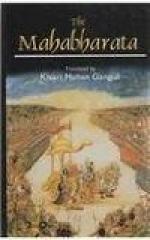107. Some texts read Santapah and not Sanghatah. The meaning then will be grief or sorrow.
108. This may refer to the exposure of other people’s weaknesses by tearing open their veils or covers.
109. Vibhajanti implies enjoyments in this connection. Telang starts a needless objection to this word.
110. ‘From even a distance.’ implies that upon even a cursory view; without even being examined minutely.
111. What is said here is this: the three qualities exist in even the immobile objects of the universe. As regards Darkness, it predominates in them. As regards Passion, it dwells in such properties of theirs as pungency, sourness, sweetness, etc, which change with time or in consequence of cooking or through admixture. Their only properties are said to appertain to Goodness. Tiryagbhavagatam is explained by Nilakantha as adhikyam gatam. Telang thinks this is unwarrantable. His own version, however, of the first line is untenable. What can be the tiryagbhava or ‘form of lower species’ of immobile objects? Telang frequently forgets that Nilakantha represents a school of interpretation not founded by him but which existed from a time long anterior to him.
112. ‘Conjunctions’ are evidently the periods joining the seasons, i.e., the close of one season and the beginning of another.
113. This probably implies that the mind, through the aid of the senses, enters into all things or succeeds in knowing them.
114. The sense seems to be that through these one succeeds in taking birth as a Brahmana.
115. A repetition occurs here of about 5 verses. The passage is evidently an interpolation originally caused by carelessness.
116. Nilakantha explains that this implies that one should regard these as really undistinguished from the mind. Indeed, created by the mind itself, these should always be taken as having no real existence beyond the mind.
117. ‘That’ here refers to the attenuation of all things by absorption into the mind.
118. Gunagunam is treating the qualities as not qualities; i.e., regarding bravery, magnanimity, etc, as really not merits, for these lead to pride. Ekacharyyam is ekantavasam, i.e., life in seclusion, or living without depending upon others. Anantaram is nirastasamastabheda or non-recognition of all distinctions. Some texts read Brahmamatah meaning ‘existing among Brahmanas’. Ekapadam sukham is samastasukhagarbham, i.e., the source or fountain of all happiness.
119. The two deities are Jiva and Iswara.
120. The correct reading, in 53 seems to be samsargabhiratam and not samsayabhiratam.
121. In the second line, the correct words are martya and sarva. The sense of the second line seems to be that this body is ceaselessly revolving, for Emancipation is difficult to achieve. Hence this body is, as it were, the wheel of Time. Nilakantha’s explanation does not seem to be satisfactory.




